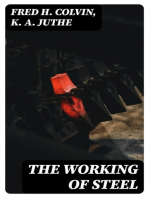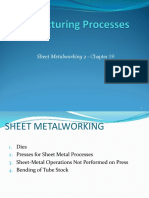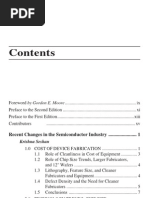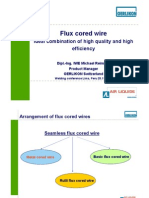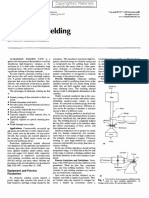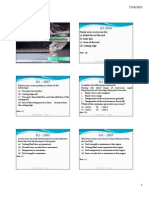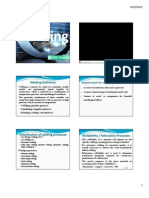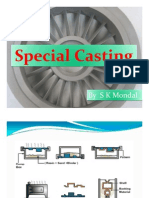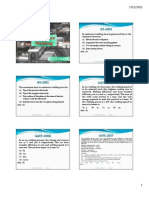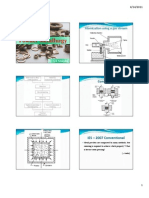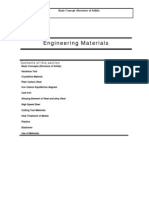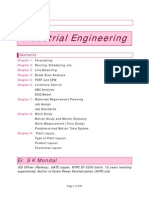Resistance and Special Welding
Resistance and Special Welding
Uploaded by
KBSMANITCopyright:
Available Formats
Resistance and Special Welding
Resistance and Special Welding
Uploaded by
KBSMANITCopyright
Available Formats
Share this document
Did you find this document useful?
Is this content inappropriate?
Copyright:
Available Formats
Resistance and Special Welding
Resistance and Special Welding
Uploaded by
KBSMANITCopyright:
Available Formats
8/26/2011
ResistanceWelding
ResistanceWelding
Principle Both heat and pressure are used. Heat is generated by the electrical resistance of the work pieces and the interface between them. Pressure is supplied externally and is varied throughout the weld cycle. Due to pressure, a lower temperature needed than oxyfuel or arc welding.
BySKMondal
Contd
They are not officially classified as solidstate welding by the American Welding Society. Very rapid and economical. Extremely well suited to automated manufacturing. l ll d d f No filler metal, no flux, no shielding gases.
Overall resistance very low. Very highcurrent (up to 100,000 A) Very lowvoltage (0.5 to 10 V) is used.
Contd
FIG.Thefundamentalresistanceweldingcircuit
Fig. The desired temperature distribution across the electrodes and the work pieces in lap resistance welding.
Fig. Typical pressure cycle welding. The forging and operations.
current and for resistance cycle includes post heating Fig. The arrangement of the electrodes and the work in spot welding, showing design for replaceable electrode tips.
8/26/2011
Advantages
1. Very rapid. 2. Fully automation possible. 3. Conserve material; no filler metal, shielding gases, or 3 metal gases flux is required. 4. Skilled operators are not required. 5.Dissimilar metals can be easily joined. 6. High reliability and High reproducibility.
Limitations
1. High initial cost. 2. Limitations to the type of joints (mostly lap joints). 3. 3 Skilled maintenance personne1 are required: 4. special surface treatment needed.
Application
The resistance welding processes are among the most common technique for high volume joining.
Differenttypes
1. Resistance spot welding 2. Resistance seam welding 3. 3 Projection welding 4. Upset welding 5. Flash welding 6. Percussion welding
Resistancespotwelding
The process description given so far is called resistance spot welding (RSW) or simply spot welding. This is essentially done to join two sheetmetal jobs in a lap j p joint, forming a small nugget at the interface of g gg the two plates.
HeatinputandEfficiencyCalculations
Contd
8/26/2011
Electric Resistance Welding Joules law applicable Q = I2 Rt, Joules
Example1
Calculate the melting efficiency in the case of arc welding of steel with a potential of 20 V and current of 200 A. The travel speed is 5 mm/s and the cross sectional area of the joint is 20 mm2. Heat required to melt steel may be taken as 10 J/ and the heat transfer efficiency as 0.85. [PTU 2004]
Example2
Calculate the melting efficiency in the case of arcwelding of steel with a potential of 20 V and a current of 200 A. The travel speed is 5 mm/s and .the cross sectional area of the joint is 20 the crosssectional mm2. Heat required to melt steel may be taken as 10 J/mm3 and the heat transfer efficiency as 0.85.
Example3
Two steel plates each 1 mm thick are spot welded at a current of 5000 A. The current flow time is 0.1 s. The electrodes used are 5 mm in diameter. diameter Determine the heat generated and its distribution in the weld zone. The effective resistance in the operation is 200 .
Example4
Two steel sheets of 1.0mm thickness are resistance welded in a lap joint with a current of 10 000 A for 0.1 second. The effective resistance of the joint can be taken as 100 micro ohms. The ohms joint can be considered as a cylinder of 5 mm diameter and 1.5mm height. The density of steel is 0.00786 g/mm3 and heat required for melting steel is 10 J/mm3.
Example5
How much heat would be generated in the spot welding of two sheets of 1 mm thick steel that required a current of 10000 A for 0.1 seconds? q An effective resistance of 100 . is assumed.
8/26/2011
Example6
Two 1.2 mm thick, flat copper sheets are being spot welded using a current of 6000 A and a current flow time of t = 0.18 s. The electrodes are 5 mm in diameter. Estimate the heat generated in the weld zone. Take effective resistance as 150 .
Example7
Two steel sheets of 1.0mm thickness are resistance welded in a projection welding with a current of 30 000 A for 0.005 second. The effective resistance of the joint can be taken as 100 micro ohms. The joint can be considered as a cylinder of 5 mm d d d l d f diameter and 1.5 mm d height. The density of steel is 0.00786 g/mm3 and heat required for melting steel is 10 J/mm3.
Resistanceseamwelding
Weld is made between overlapping sheets of metal. The seam is a series of overlapping spot welds. The basic equipment is the same as for spot welding. welding except that the electrodes are now in the form of rotating disks. Timed pulses of current pass to form the overlapping welds.
Contd
Welding current is a bit higher than spot welding, to compensate short circuit of the adjacent weld. In other process a continuous seam is produced by passing a continuous current through the rotating electrodes with a speed of 1.5 m/min for thin sheet.
Contd
Projectionwelding
Limitations of spot welding. 1. Electrode condition must be maintained continually, and only one spot weld at a time. 2. For additional strength multiple welds needed. Projection welding (RPW) overcomes above limitations.
Fig.Resistanceseamwelding
Contd
8/26/2011
Dimples are embossed on work pieces at the weld locations and then placed between largearea electrodes, and pressure and current applied like spot welding. Current flows through the dimples and heats them and pressure causes the dimples to flatten and form a weld.
Fig.Principleof projectionwelding, (a)priortoapplicationof currentandpressure (b)andafterformationof welds
Contd
Projections are pressformed in any shape. Multiple welds at a time. No indentation mark on the surface. Bolts and nuts can be attached to other metal parts.
Upsetwelding
Made butt joint compared to lap joint. Pieces are held tightly and current is applied. Due to pressure joints get slightly upset and hence its name. Useful for joining rods or similar pieces.
Contd
Contd
This is the process used for making electric resistance welded (ERW) pipes starting from a metal plate of suitable thickness. The plate is first formed into the shape of the pipe with the help of the three roll set as shown in Fig. above. The ends of the p plate would then be forming the butt j g joint. The two rotating copper disc electrodes are made to contact the two ends of the plate through which the current is passed. The ends get heated and then forge welded under the pressure of the rolls. The ends of the pieces to be upset welded must be perfectly parallel. Any high spots if present on the ends would get melted first before the two ends are completely joined.
FlashWelding
It is similar to upset welding except the arc rather than resistance heating. One pieces is clamped with cam controlled movable platen and other with is fixed platen.
Contd
8/26/2011
Two pieces are brought together and the power supply is switched on. Momentarily the two pieces are separated to create the arc to melt the ends of the two pieces. Then again the pieces are brought together and the power switched off while the two ends are fused under force. Most of the metal melted would flash out through the joint and forms like a fin around the joint. Faster than upset welding.
PercussionWelding
Similar to flash welding except arc power by a rapid discharge of stored electrical energy. The arc duration is only 1 to 10 ms, heat is intense and y highly concentrated. Small weld metal is produced, little or no upsetting, and low HAZ. Application: Butt welding of bar or tube where heat damage is a major concern.
Contd
OtherWelding h i Technique
Thermit Welding
Heating and coalescence is by superheated molten metal obtained from a chemical reaction between a metal oxide and a metallic reducing agent. g g Used mixture one part aluminum and three parts iron oxide and ignited by a magnesium fuse. (1150C). 8Al+3Fe3O4 9Fe+4Al2O3 +heat
Temp. 2750C produced in 30 seconds, superheating the molten iron which provide both heat and filler metal. Runners and risers are provided like casting. Copper, brass, and bronze can be welded using a different starting mixture. Used to joint thick sections, in remote locations.
Contd
8/26/2011
ElectroSlagWelding
Very effective for welding thick sections. Heat is derived from the passage of electrical current through a liquid slag and temp. 1760 C temp 1760C
A 65mm deep layer of molten slag, protect and cleanse the molten metal. Watercooled copper molding plates confined the liquid and moved upward. Multiple electrodes are used to provide an adequate supply of filler.
Contd
Contd
Applications: Shipbuilding, machine manufacture, heavy pressure vessels, and the joining of large castings and forgings. Slow cooling p g produces a coarse g grain structure. Large HAZ.
Contd
ElectronBeamWelding
A beam of electrons is magnetically focused on the work piece in a vacuum chamber. Heat of fusion is produced by electrons decelerate. decelerate Allows precise beam control and deep weld
penetration. No shield gas (vacuum chamber used)
8/26/2011
LaserBeamWelding
Used a focused laser beam provides power intensities in excess of 10kW/cm2
Very thin HAZ and little thermal distortion. Filler metal and inert gas shield may or may not used. Deep penetration. No N vacuum needed. d d No direct contact needed.
The high intensity beam produces a very thin column highintensity of vaporized metal with a surrounding liquid pool. Depthtowidth ratio greater than 4: 1.
Contd
Contd
Heat input is very low, often in the range 0.1 to 10 J. Adopted by the electronics industry. Possible to weld wires without removing the
ForgeWelding
Blacksmith do this. Borax is used as a flux. The ends to be joined were then overlapped on the anvil and hammered to the degree necessary to produce an acceptable weld. Quality depends on the skill of the worker and not used by industry.
Contd
polyurethane insulation. insulation
FrictionWelding
Heat is obtained by the friction between the ends of the two parts to be joined. One part is rotated at a high speed and other part is axially aligned and pressed tightly against it. Friction raises the temperature of both the ends. Then rotation is stopped abruptly and the pressure is increased to join.
Contd
Machine is similar to a centre lathe. Power requirements 25 kVA to 175 kVA. The axial pressure depends on the strength and hardness of the metals being joined. Pressure 40 MPa for lowcarbon steels to as high as 450 4 g 45 MPa for alloy steels.
Contd
8/26/2011
Very efficient. Wide variety of metals or combinations of metals can be joined such as aluminium to steel. Grain size is refined Strength is same as base metal. metal Only round bars or tubes of the same size, or connecting bars or tubes to flat surfaces can join. One of the components must be ductile. Friction welding is a solid state welding.
Fig frictionweldingprocess
Contd
UltrasonicWelding(USW)
USW is a solidstate welding. Highfrequency (10 to 200, KHz) is applied. Surfaces are held together under light normal
Restricted to the lap joint Weld thin materialssheet, foil, and wireor the
attaching thin sheets to heavier structural members.
Maximum thickness 2.5 mm for aluminum and 1.0
pressure. Temp. do not exceed onehalf of the melting point. The ultrasonic transducer is same as ultrasonic machining.
mm for harder metals. N b of metals and di i il metal combinations Number f t l d dissimilar t l bi ti and non metals can be joined such as aluminum to ceramics or glass. Equipment is simple and reliable. Less surface preparation and less energy is needed.
Contd
Contd
Applications
Joiningthedissimilarmetalsinbimetallics Makingmicrocircuitelectricalcontacts. Weldingrefractoryorreactivemetals ld f l Bondingultrathinmetal.
ExplosionWelding
Done at room temperature in air, water or vacuum. Surface contaminants tend to be blown off the surface. Typical impact pressures are millions of psi psi. Well suited to metals that is prone to brittle joints when heat welded, such as,
Aluminum on steel Titanium on steel
Contd
8/26/2011
Important factors are, Critical velocity Critical angle The cladding plate can be supported with tack welded supports at the edges, or the metal inserts.
Typically the detonation velocity should not exceed 120% of the sonic velocity in the metal.
Contd
Contd
High velocity explosives, 45727620 m/s. TNT RDX PETN Composition B Composition C4 Datasheet Primacord Medium velocity explosives, 15244572 m/s Ammonium nitrate Ammonium perchlorate Amatol Nitroguonidine Dynamites diluted PETN
Contd
Advantages, Can bond many dissimilar, normally unweldable metals The lack of heating preserves metal treatment The Th process i compact, portable, and easy to contain is bl d i Inexpensive No need for surface preparation
Contd
Disadvantages, The metals must have high enough impact resistance, and ductility (at least 5%) The cladding plate cannot be too large. Noise and blast can require worker protection, vacuum protection chambers, buried in sand/water.
Typicalapplications: Verylargeplatescanbecladded. Joinsdissimilarmetals. (titaniumtosteel,Altosteel,AltoCuetc.) Jointubetotubesheetsoflargeheatexchangers.
Contd
Contd
10
8/26/2011
Autogeneous Welding
Autogeneous welding or fusion of the parent material in an inert gas shield without the use of filler metals.
MicroPlasmaArcWeld(PAW)
Similar to GTAW except the plasma caused by the arc is constricted by a watercooled orifice Capable of high welding speeds where size permits Argon is used as the shielding gas.
BrazingandSoldering g g
BrazingandSoldering
Brazing is the joining of metals through the use of heat and a filler metal whose melting temperature is above 450C; but below the melting point of the metals being joined. Comparison with welding and the brazing process 1. The composition of the brazing alloy is significantly Th ii f h b i ll i i ifi l different from that of the base metal. 2. The strength of the brazing alloy is substantially lower than that of the base metal. 3. The melting point of the brazing alloy is lower than that of the base metal, so the base metal is not melted. 4. Capillary action or capillary attraction draws the molten filler metal into the joint, even against the flow of gravity.
11
8/26/2011
Brazingprocesshasseveraldistinct advantages:
1. All metals can be joined. 2. Suited for dissimilar metals. 3. Quick and economical. 4. Less defects.
Corrosion prone
Contd
Extremely clean surface needed. Brazingmetalsaretypicallyalloyssuchas, Brazingbrass(60%Cu,40%Zn) Manganesebronze Nickelsilver Coppersilicon Silveralloys(with/withoutphosphorous) Copperphosphorous Fluxes used are combinations of borax, boric acid, chlorides, fluorides, tetraborates and other wetting agents. g
Contd
Contd
A popular composition is 75% borax and 25% boric acid. Sodium cyanide is used in brazing tungsten to copper. Base materials not melted. melted
12
8/26/2011
BrazeWelding
Capillary action is not required. Edge preparation needed. Can join cast iron. iron
Done with an oxyacetylene torch.
Contd
Fig.BrazeWelding
Soldering
By definition, soldering is a brazing type of operation where the filler metal has a melting temperature below 45 450C. Strength of the filler metal is low. Soldering is used for a neat leakproof joint or a low resistance electrical joint. Not suitable for hightemp. application.
Contd
Effective soldering generally involves six important steps: (1) Design of an acceptable solder joint, (2) Selection of the correct solder for the job, (3) Selection of the proper type of flux, (4) Cleaning the surfaces to be joined, (5) Application of flux, solder, and sufficient heat to allow the molten solder to fill the joint by capillary action and solidify, and (6) Removal of the flux residue, if necessary.
SolderMetals
Most solders are alloys of lead and tin. Three commonly used alloys contain 60, 50, and 40% tin and all melt below 240 C. 240C
SolderFlux
Ammonium chloride or rosin for soldering tin Hydrochloric acid and zinc chloride for soldering galvanized iron Some fluxes are corrosive and should be removed after use
Contd
13
8/26/2011
Silver solders uses for highertemperature service, Electrical and Electronic purpose.
DifficultieswithGreyCastIron
Soldering and brazing are difficult of grey cast Iron due to surface contamination with graphite having a very low surface energy.
Weldingdesignanddefect
Welding Problem Cracking of weld metal Cracking of base metal Spatter Distortion Slag inclusion Porosity Causes High joint rigidity Excessive stresses Arc blow Poor joint selection Improper cleaning in multipass welding Excessive H2, O2, N2, in the welding atmosphere or Damp electrodes inclusionssuchasMn FeandS inthebasemetaland/or residualstress
Residualstress
The residual stresses result from the restrained expansion and contraction that occur during localized heating and cooling in the region of weld deposit. The magnitude of residual stresses depends on the weldment design, design support and clamping of the components being welded, their materials, welding process used, part dimensions, welding sequence, post weld treatment, size of the deposited weld beads, etc. Residual stresses should not have a harmful effect on the strength performance of weldments, reduces fatigue strength, May cause distortion. This residual stress may result in the cracking of a brittle material and is not important as far as a ductile material.
LamellarTearing
14
7/11/2011
IES2003
Resistance Welding
Inresistancewelding,heatisgeneratedduetothe resistancebetween (a) Electrodeandworkpiece (b) Asperitiesbetweentouchingplates (c) Twodissimilarmetalsbeingincontact (d) Interatomicforces Ans.(b)
BySKMondal
Compiledby:SKMondal MadeEasy
Compiledby:SKMondalMadeEasy
IES2001
Themaximumheatinresistanceweldingisatthe (a) Tipofthepositiveelectrode (b) Tipofthenegativeelectrode (c) Topsurfaceoftheplateatthetimeofelectric contactwiththeelectrode (d) InterfacebetweenthetwoplatesbeingJoined Ans.(d)
GATE2008
In arc welding of a butt joint, the welding speed is to be selected such that highest cooling rate is achieved. Melting efficiency and heat transfer efficiency are 0.5 and 0.7, respectively. The area of the weld cross section is 5 mm2 and the unit h ld d h energy required to melt the metal is 10 J/mm3. If the welding power is 2 kW, the welding speed in mm/s is closest to (a) 4 (b) 14 (c) 24 (d) 34 Ans. (b)
Compiledby:SKMondalMadeEasy
Compiledby:SKMondalMadeEasy
GATE2006
In an arc welding process, the voltage and current are 25 V and 300 A respectively. The arc heat transfer efficiency is 0.85 and welding speed is 8 mm/see. The net heat input (in J/mm) is (a) 64 (b) 797 (c) 1103 (d) 79700 Ans. (b)
Compiledby:SKMondalMadeEasy
GATE2007
Two metallic sheets, each of 2.0 mm thickness, are welded in a lap joint configuration by resistance spot welding at a welding current of 10 kA and welding time of 10 millisecond. A spherical fusion zone extending up to the full thickness of each sheet is formed. The properties of the metallic sheets are given as: ambient temperature = 293 K melting temperature = 1793 K latent heat of fusion = 300 kJ/kg density = 7000 kg/m3 specific heat = 800 J/kg K Assume: (i) Contact resistance along sheetsheet interface is 500 microohm and along electrodesheet interface is zero; (ii) No conductive heat loss through the bulk sheet materials; and (iii) The complete weld fusion zone is at the melting temperature. The melting efficiency (in %) of the process is (a) 50.37 (b) 60.37 (c) 70.37 (d) 80.37 Ans. (c)
Compiledby:SKMondalMadeEasy
7/11/2011
GATE2005
Spot welding of two 1 mm thick sheets of steel (density = 8000 kg/m3) is carried out successfully by passing a certain amount of current for 0.1 second through the electrodes. The resultant weld nugget formed is 5 mm in diameter and 1.5 mm f d d d thick. If the latent heat of fusion of steel is 1400 kJ/kg and the effective resistance in the welding operation in 200 , the current passing through the electrodes is approximately (a) 1480A (b) 3300 A (c) 4060 A (d) 9400 A Ans. (c)
Compiledby:SKMondalMadeEasy
GATE2001
Resistance spot welding is performed on two plates of 1.5 mm thickness with 6 mm diameter electrode, using 15000 A current for a time duration of 0.25 seconds. Assuming the interface resistance to b 0.0001 , the h be h heat generated to d form the weld is (a) 5625 Wsec (b) 8437 Wsec (c) 22500 Wsec (d) 33750 Wsec Ans. (a)
Compiledby:SKMondalMadeEasy
GATE2004
Two 1 mm thick steel sheets are to be spot welded at a current of 5000 A. Assuming effective resistance to be 200 microohms and current flow time of 0.2 second, heat generated during the process will be ll b (a) 0.2 Joule (b) 1 Joule (c) 5 Joule (d) 1000 Joules Ans. (d)
GATE1992
For resistance spot welding of 1.5 mm thick steel sheets, the current required is of the order of (a) 10 A (b) 100 A (c) 1000 A (d) 10,000 A Ans. (d)
Compiledby:SKMondalMadeEasy
Compiledby:SKMondalMadeEasy
GATE2010
Two pipes of inner diameter 100 mm and outer diameter 110 mm each joined by flash butt welding using 30 V power supply. At the interface, 1 mm of material melts from each pipe which has a resistance of 42.4 . If the unit melt energy is 64.4 MJm3, then time required for welding in seconds is (a) 1 (b) 5 (c) 10 (d) 20 Ans. (c)
IAS2003
Assertion (A): Spot welding is adopted to weld two overlapped metal pieces between two electrode points. Reason (R): In this process when current is switched on, the lapped pieces of metal are heated in a restricted area. (a) Both A and R are individually true and R is the correct explanation of A (b) Both A and R are individually true but R is not the correct explanation of A (c) A is true but R is false (d) A is false but R is true Ans. (a)
Compiledby:SKMondalMadeEasy
Compiledby:SKMondalMadeEasy
7/11/2011
Example1
Calculate the melting efficiency in the case of arc welding of steel with a potential of 20 V and current of 200 A. The travel speed is 5 mm/s and the cross sectional area of the joint is 20 mm2. Heat required to melt steel may be taken as 10 J/ and the heat transfer efficiency as 0.85. [PTU 2004]
Example2
Calculate the melting efficiency in the case of arcwelding of steel with a potential of 20 V and a current of 200 A. The travel speed is 5 mm/s and .the crosssectional area of the joint is 20 the cross sectional mm2. Heat required to melt steel may be taken as 10 J/mm3 and the heat transfer efficiency as 0.85.
Compiledby:SKMondalMadeEasy
Compiledby:SKMondalMadeEasy
Example3
Two steel plates each 1 mm thick are spot welded at a current of 5000 A. The current flow time is 0.1 s. The electrodes used are 5 mm in diameter. Determine the heat generated and diameter its distribution in the weld zone. The effective resistance in the operation is 200 .
Example4
Two steel sheets of 1.0mm thickness are resistance welded in a lap joint with a current of 10 000 A for 0.1 second. The effective resistance of the joint can be taken as 100 micro ohms The ohms. joint can be considered as a cylinder of 5 mm diameter and 1.5mm height. The density of steel is 0.00786 g/mm3 and heat required for melting steel is 10 J/mm3.
Compiledby:SKMondalMadeEasy
Compiledby:SKMondalMadeEasy
Example5
How much heat would be generated in the spot welding of two sheets of 1 mm thick steel that required a current of 10000 A for 0.1 seconds? q An effective resistance of 100 . is assumed.
Example6
Two 1.2 mm thick, flat copper sheets are being spot welded using a current of 6000 A and a current flow time of t = 0.18 s. The electrodes are 5 mm in diameter. Estimate the heat generated in the weld zone. Take effective resistance as 150 .
Compiledby:SKMondalMadeEasy
Compiledby:SKMondalMadeEasy
7/11/2011
Example7
Two steel sheets of 1.0mm thickness are resistance welded in a projection welding with a current of 30 000 A for 0.005 second. The effective resistance of the joint can be taken as 100 micro ohms. The joint can be considered as a cylinder of 5 mm diameter and 1.5 mm d d l d f d d height. The density of steel is 0.00786 g/mm3 and heat required for melting steel is 10 J/mm3.
OtherWelding Technique h i
Compiledby:SKMondalMadeEasy
Compiledby:SKMondalMadeEasy
IES2000
Considerthefollowingprocesses: 1. Gaswelding 2. Thermit welding 3 Arcwelding 3. g 4. Resistancewelding Thecorrectsequenceoftheseprocessesinincreasing orderoftheirweldingtemperaturesis (a) 1,3,4,2 (b) 1,2,3,4 (c) 4,3,1,2 (d)4,1,3,2 Ans.(d)
Compiledby:SKMondalMadeEasy
IAS2003
Whichoneofthefollowingisnotanelectric resistancemethodofwelding? (a) Electroslagwelding (b) Percussionwelding (c) Seamwelding (d) Flashwelding Ans.(a)
Compiledby:SKMondalMadeEasy
IAS2000
Considerthefollowingweldingprocesses: 1. TIGwelding 2. Submergedarcwelding 3. Electroslagwelding4. Thermit welding Whichoftheseweldingprocessesareusedforwelding Whi h fth ldi df ldi thickpiecesofmetals? (a) 1,2and3 (b) 1,2and4 (c) 1,3and4 (d) 2,3and4 Ans.(d)
IES2004
Assertion (A): In electron beam welding process, vacuum is an essential process parameter Reason (R): Vacuum provides a highly efficient shield on weld zone (a) Both A and R are individually true and R is the correct explanation of A (b) Both A and R are individually true but R is not the correct explanation of A (c) A is true but R is false (d) A is false but R is true Ans. (d)
Compiledby:SKMondalMadeEasy
Compiledby:SKMondalMadeEasy
7/11/2011
IES2002
Inwhichoneofthefollowingweldingtechniques isvacuumenvironmentrequired? (a) Ultrasonicwelding (b) Laserbeamwelding (c) Plasmaarcwelding (d) Electronbeamwelding Ans.(d)
IES1993
Electronbeamweldingcanbecarriedoutin (a) Openair (b) Ashieldinggasenvironment (c) Apressurizedinertgaschamber ( ) A i di t h b (d) Vacuum Ans.(d)
Compiledby:SKMondalMadeEasy
Compiledby:SKMondalMadeEasy
IAS2004
Whichoneofthefollowingweldingprocesses consistsofsmallerHeatAffectedZone(HAZ)? (a) Arcwelding (b) Electronbeamwelding (c) MIGwelding (d) Thermit welding Ans.(b)
IES2007
Considerthefollowingstatementsinrespectofthe laserbeamwelding: 1. Itcanbeusedforweldinganymetalortheir combinationsbecauseofveryhightemperatureofthe focalpoints. focalpoints 2. Heataffectedzoneisverylargebecauseofquick heating. 3. Highvacuumisrequiredtocarrytheprocess. Whichofthestatementsgivenaboveis/arecorrect? (a) 1and2only (b) 2and3only (c) 1only (d) 1,2and3 Ans.(c)
Compiledby:SKMondalMadeEasy
Compiledby:SKMondalMadeEasy
IES2006
Whichoneofthefollowingweldingprocesses consistsofminimumheataffectedzone(HAZ)? (a) ShieldedMetalArcWelding(SMAW) (b) LaserBeamWelding(LBW) (c) UltrasonicWelding(USW) (d) MetalInertGasWelding(MIG) Ans.(b)
IAS2007
Consider the following welding processes: 1. Arc welding 2. MIG welding 3. Laser beam welding 4. Submerged arc welding Select the correct sequence in increasing order of Heat affected zone (HAZ) using the code given below: (a) 1 2 3 4 (b) 1 4 2 3 (c) 3 2 4 1 (d) 4 3 2 1 Ans. (c)
Compiledby:SKMondalMadeEasy
Compiledby:SKMondalMadeEasy
7/11/2011
IAS1999
Match List I (Shielding method) with List II (Welding process) and select the correct answer using the codes given below the lists: List I List II A. Flux coating 1. Gas metal arc welding B. Flux granules 2. Submerged arc welding B Fl l S b d ldi C. CO2 3. Shielded metal arc welding D. Vacuum 4. Laser beam welding 5. Electron beam welding Codes:A B C D A B C D (a) 1 2 5 3 (b) 1 4 2 5 (c) 3 5 1 4 (d) 3 2 1 5 Ans. (d)
Compiledby:SKMondalMadeEasy
GATE2007
Whichoneofthefollowingisasolidstatejoining process? (a) Gastungstenarcwelding (b) Resistancespotwelding (c) Frictionwelding (d) submergedarcwelding Ans.(c)
Compiledby:SKMondalMadeEasy
IES2011S1Contd
GATE1992
Inanexplosiveweldingprocess,the.. (maximum/minimum)velocityofimpactisfixed bythevelocityofsoundinthe (flyer/target)platematerial (a) Maximum;target (b) Minimum;target (c) Maximum;flyer (d) Minimum;flyer Ans.(c)
Compiledby:SKMondalMadeEasy
MatchListIwithListIIandselectthecorrectanswer usingthecodegivenbelowthelists:
ListI ListII A.Laserbeam 1.Canbeappliedforweldingorrefractorymetals welding likeniobium,tantalum,molybdenumandtungsten. B.Electron 2.Asoundandcleanweldedjointiscreateddueto beamwelding rubbingoftwopartsagainsteachotherwith adequatespeedandpressureproducingintenseheat raisingtemperatureabovemeltingpoint. C.Ultrasonic 3.Cleanheatsourcecreatedmuchawayfromjob,a welding narrowspotisheated,workchamberoperatesina highvacuum. D.Friction welding 4.Cleanheatsourceveryquickheating,verysmall focalspot,novacuumchamberisrequired.
Compiledby:SKMondalMadeEasy
IES2011FromS1
Codes: A (a) 4 ( ) 4 (c) Ans.(a) B 3 1 C 1 3 D 2 4 (b) ( ) (d) A 2 2 B 3 1 C 1 3 D 4 4
IES2009
MatchListIwithListIIandselectthecorrectanswerusingthecodegiven belowtheLists: ListI ListII (WeldingProcess) (Application) A. Laserwelding 1. Unitinglargeareasheets B. Frictionwelding 2. Repairinglargeparts C. 3. C Ultrasonicwelding 3 Weldingarodtoaflatsurface D. Explosivewelding 4. Fabricationofnuclearreactor components 5. Weldingverythinmaterials Code: (a) A B C D (b) A B C D 5 4 3 2 1 4 2 5 (c) Ans.(d) A 1 B 3 C 4 D 2 (d) A 5 B 3 C 4 D 1
Compiledby:SKMondalMadeEasy
Compiledby:SKMondalMadeEasy
7/11/2011
IAS2002
MatchListI,(Welding)withListII(Application)andselectthecorrect answerusingthecodesgivenbelowtheLists: ListI ListII (Welding) (Application) A. Explosive 1. Joiningthicksheets g B. Ultrasonic 2. Manufactureofheatexchanges C. Thermit 3. Joiningthinsheetsorwiresof similar/dissimilar metals D. Projection 4. Joininghydraulicpistonrodsfor agricultural machinery 5. Joiningrails,pipesandthicksteel sections Codes:A B C D A B C D (a) 2 5 1 3 (b) 4 5 1 3 (c) 2 3 5 1 (d) 4 3 5 1 Ans.(c)
Compiledby:SKMondalMadeEasy
IAS2001
MatchListI(Weldingprocesses)withListII(Features)and selectthecorrectanswerusingthecodesgivenbelowtheLists: ListI A. Ultrasonicwelding B. C. 1. ListII Gasheatedtoionizedcondition forconductionofelectriccurrent Highfrequencyandhigh intensityvibrations Concentratedstreamofhigh energyelectrons Exothermalchemicalreaction A B C (b) 4 3 1 (d) 2 3 1
Electronbeamwelding2. Plasmaarcwelding A 1 2 B 2 1 3. 4. C 4 4
Codes: (a) (c) Ans.(d)
Compiledby:SKMondalMadeEasy
JWM2010
MatchListIwithListIIandselectthecorrectanswer usingthecodegivenbelowthelists:
ListI ListII A.Atomic 1.Twopiecesarebroughttogetherand hydrogenwelding powersupplyisswitchedon B.Plasmaarc B Plasma arc welding C.Spotwelding D.Flashwelding 2.Nuggetisformedattheinterfaceof 2 Nuggetisformedattheinterfaceof twoplates 3.Gasisionized 4.Inertgasshieldedarcwelding
BrazingandSoldering g g
D 4 4
Code:A (a) 4 (c) 4
B 3 2
C D A 2 1 (b) 1 3 1 (d) 1 Compiledby:SKMondalMadeEasy
B 3 2
C 2 3
Compiledby:SKMondalMadeEasy
GATE2005
Thestrengthofabrazedjoint (a) Decreaseswithincreaseingapbetweenthetwo joiningsurfaces (b) Increaseswithincreaseingapbetweenthetwo joiningsurfaces j i i f (c) Decreasesuptocertaingapbetweenthetwo joiningsurfacesbeyondwhichitincreases (d) Increasesuptocertaingapbetweenthetwo joiningsurfacesbeyondwhichitdecreases Ans.(d)
Compiledby:SKMondalMadeEasy
IES2006
Whichoneofthefollowingisnotafusionwelding process? (a) Gaswelding (b) Arcwelding (c) Brazing (d) Resistancewelding Ans.(c)
Compiledby:SKMondalMadeEasy
7/11/2011
IES1994
MatchList IwithList IIandselectthecorrectanswer usingthecodesgivenbelowtheLists: List I(Filler) List II(Joiningprocess) A. Cu,Zn,Agalloy 1. Brazewelding. B. Cu,Sn,alloy 2. Brazing C. Pb,Sb,alloy 3. Soldering D.Iron oxideandaluminium powder4. TIGweldingof aluminium Codes:A B C D A B C D (a) 2 1 3 (b) 1 2 4 (c) 2 1 3 4 (d) 2 3 4 Ans.(a)
Compiledby:SKMondalMadeEasy
IAS1996
MatchListIwithListIIandselectthecorrectanswerusing thecodesgivenbelowthelists ListI ListII (Fillerrodmaterial) (Joiningprocess) A. Mildsteel 1. MIGwelding B. Bronze 2. Soldering C. Brass 3. Brazing D. Leadandtinalloy 4. Thermit welding 5. Brazewelding Codes:A B C D A B C D (a) 1 5 3 2 (b) 4 3 2 5 (c) 4 3 5 2 (d) 1 3 5 4 Ans.(a)
Compiledby:SKMondalMadeEasy
IES2004
MatchListI(Weldingproblems)withListII(Causes)andselect thecorrectanswerusingthecodesgivenbelowtheLists: ListI ListII A. Crackingofweldmetal 1. Excessivestresses B. Crackingofbasemetal 2. Highjointrigidity C. Porosity C 3. 3 Failuretoremoveslag frompreviousdeposit D. Inclusions 4. Oxidation 5. ExcessiveH2,O2,N2,in theweldingatmosphere Codes:A B C D A B C D (a) 2 1 5 3 (b) 3 4 2 1 (c) 2 4 5 3 (d) 3 1 4 2 Ans.(a)
Compiledby:SKMondalMadeEasy
IES2003
MatchListI(WeldingDefects)withListII(Causes)and selectthecorrectanswerusingthecodesgivenbelowthe Lists: ListI ListII (WeldingDefects) (Causes) A. Spatter A S 1. Dampelectrodes D l d B. Distortion 2. Arcblow C. Slaginclusion 3. Impropercleaningin multipasswelding D. Porosity 4. Poorjointselection Codes:A B C D A B C D (a) 4 2 3 1 (b) 4 2 1 3 (c) 2 4 1 3 (d) 2 4 3 1 Ans.(d)
Compiledby:SKMondalMadeEasy
IES2004
Consider the following statements: The magnitude of residual stresses in welding depends upon 1. Designofweldment 2. Supportandclampingofcomponents S d l f 3. weldingprocessused 4. Amountofmetalmelted/deposited Whichofthestatementsgivenabovearecorrect? (a) 1,2and4 (b)1,2and3 (c) 1and3 (d)2and3 Ans.(b)
Compiledby:SKMondalMadeEasy
GATE2003
Matchthefollowing Workmaterial P.Aluminium Q.DieSteel R.CopperWire S.Titaniumsheet Typeofjoining 1. SubmergedArcWelding 2. Soldering 3. Thermit Welding 4. AtomicHydrogenWelding 5. GasTungstenArcWelding 6. LaserBeamWelding 7. Brazing S 3 S 4 S 2 S 6
(a)P 2 (b)P 6 (c)P 4 (d)P 5 Ans.(d)
Q 5 Q 3 Q 1 Q 4
R 1 R 4 R 6 R 2
Compiledby:SKMondalMadeEasy
7/11/2011
IES2004
Considerthefollowingstatements: Thesizeoftheheataffectedzone(HAZ)willincreasewith 1. Increasedstartingtemperature 2. Increasedweldingspeed 3. Increasedthermalconductivityofthebasemetal 4. Increaseinbasemetalthickness Whichofthestatementsgivenabovearecorrect? (a) 1,2and3 (b) 1and3 (c) 1and4 (d) 2and3 Ans.(b)
Compiledby:SKMondalMadeEasy
IES1992
Weldspatteroccursduetoanyofthefollowing except (a) Highweldingcurrent (b) Toosmallanelectrode (c) Arc (d) Wrongpolarity Ans.(d)
Compiledby:SKMondalMadeEasy
JWM2010
Assertion (A) : Spatter is one of the welding defects. Reason (R) : In submerged arc welding process, there is no spatter of molten metal. (a) Both A and R are individually true and R is the correct explanation of A (b) Both A and R are individually true but R is not the correct explanation of A (c) A is true but R is false (d) A is false but R is true Ans. (b)
Compiledby:SKMondalMadeEasy
IES1998
Anarcweldedjointisshownintheabovefigure. Thepartlabelled 'B'inthefigureisknownas (a) Weldpreparation (b) Penetration (c) Reinforcement (d) Slag
Ans.(c)
Compiledby:SKMondalMadeEasy
IES2004
Assertion (A): A sound welded joint should not only be strong enough but should also exhibits a good amount of ductility Reason (R): Welding process is used for fabricating mild steel components only (a) Both A and R are individually true and R is the correct explanation of A (b) Both A and R are individually true but R is not the correct explanation of A (c) A is true but R is false (d) A is false but R is true Ans. (c)
Compiledby:SKMondalMadeEasy
IAS2003
Toolmaterialnotsuitedtoresistanceweldingis (a) Aluminium oxide (b) Stellite (c) Highspeedsteel (d) Masonite Ans.(a)
Compiledby:SKMondalMadeEasy
7/11/2011
GATE1996
Preheatingbeforeweldingisdoneto (a) Makethesteelsofter (b) Bumawayoil,grease,etc,fromtheplatesurface (c) Preventcoldcracks (d) Preventplatedistortion Ans.(c)
Coldcrackinginsteelweldments dependson 1.Carbonequivalent 2.Heatinput 3.Effectivethickness 3.Hydrogencontentinweldpool H d i ld l (a)1,2and3only (b)1,2and4only (c)2,3and4only (d)1,2,3and4 Ans.(d)
Compiledby:SKMondalMadeEasy
IES2011
Compiledby:SKMondalMadeEasy
GATE2001
Two plates of the same metal having equal thickness are to be butt welded with electric arc. When the plate thickness changes, welding is achieved by (a) Adjusting the current (b) Adjusting the duration of current (c) Changing the electrode size (d) Changing the electrode coating Ans. (a)
Compiledby:SKMondalMadeEasy Compiledby:SKMondalMadeEasy
10
You might also like
- AE2253 Unit 2Document15 pagesAE2253 Unit 2Jones Jones Jr.No ratings yet
- Surface Finish Study - ES - ITP AeroDocument128 pagesSurface Finish Study - ES - ITP AeroXabier SalazarNo ratings yet
- Rolling Fig Q A AnalysisDocument11 pagesRolling Fig Q A AnalysisRavinder Antil100% (9)
- Production Question Set 2013 by S K MondalDocument63 pagesProduction Question Set 2013 by S K MondalKBSMANIT60% (5)
- Arc Welding Process PDFDocument12 pagesArc Welding Process PDFBiswanath RoulNo ratings yet
- Oxy-Acetylene Welding and Cutting: Electric, Forge and Thermit Welding together with related methods and materials used in metal working and the oxygen process for removal of carbonFrom EverandOxy-Acetylene Welding and Cutting: Electric, Forge and Thermit Welding together with related methods and materials used in metal working and the oxygen process for removal of carbonNo ratings yet
- The Working of Steel: Annealing, Heat Treating and Hardening of Carbon and Alloy SteelFrom EverandThe Working of Steel: Annealing, Heat Treating and Hardening of Carbon and Alloy SteelNo ratings yet
- Welding Terminology: A Guide to MIG, TIG, Stick, Gas, and Spot Welding TermsFrom EverandWelding Terminology: A Guide to MIG, TIG, Stick, Gas, and Spot Welding TermsNo ratings yet
- Stretch Forming JomyDocument33 pagesStretch Forming JomyJoNo ratings yet
- Sheet Metalworking 2 - Chapter 19Document67 pagesSheet Metalworking 2 - Chapter 19xharpreetxNo ratings yet
- Plastic Welding: M. Fadlan Alamsyah Satria Bintang P. Toto Satrio W. Michael OloanDocument14 pagesPlastic Welding: M. Fadlan Alamsyah Satria Bintang P. Toto Satrio W. Michael OloanFadlanbunglon100% (1)
- Nano Finishing TechniquesDocument30 pagesNano Finishing TechniquesSujay SaxenaNo ratings yet
- Sheet Metal Forming (2) - 2Document30 pagesSheet Metal Forming (2) - 2Wakahare PtahNo ratings yet
- Unit IV 180208091907Document153 pagesUnit IV 180208091907tamilselvan nNo ratings yet
- Dayton Tech BalllockDocument12 pagesDayton Tech BalllockNaukowyDrpNo ratings yet
- Powder MetallurgyDocument3 pagesPowder Metallurgysrinivas100% (1)
- Dayton Rogers Design Handbook E-EditionDocument42 pagesDayton Rogers Design Handbook E-EditionÉmilie RiverinNo ratings yet
- Handbook of Thin-FilmDocument12 pagesHandbook of Thin-Filmdhook_mmmNo ratings yet
- Welding of Tool Steel - Uddeholm (Ebook, 17 Pages)Document17 pagesWelding of Tool Steel - Uddeholm (Ebook, 17 Pages)Ismael 8877No ratings yet
- Chapter3 The Structure and Design of Press DiesDocument35 pagesChapter3 The Structure and Design of Press DiesMiriam OuxNo ratings yet
- Chapter 4Document20 pagesChapter 4Vandan GundaleNo ratings yet
- Basics of Injection Molding DesignDocument23 pagesBasics of Injection Molding DesignVinay Kumar Kumar100% (1)
- Welding MetallurgyDocument17 pagesWelding Metallurgydanish moinNo ratings yet
- Vacuum CastingDocument5 pagesVacuum CastingHarpreetSinghNo ratings yet
- Aluminum 5083 With 5183Document9 pagesAluminum 5083 With 5183johnknight000No ratings yet
- MP-I - Unit 5 - Sheet Metal WorkingDocument60 pagesMP-I - Unit 5 - Sheet Metal WorkingTirumala Height Phase-INo ratings yet
- Understanding Magnesium Heat TreatmentDocument2 pagesUnderstanding Magnesium Heat Treatmentmp87_ingNo ratings yet
- Investigation of Al Welding Through MIG Welding ProcessDocument92 pagesInvestigation of Al Welding Through MIG Welding ProcessMert KarakaplanNo ratings yet
- Semi Solid Metal CastingDocument2 pagesSemi Solid Metal CastingSuresh KumarNo ratings yet
- Special Forming ProcessDocument11 pagesSpecial Forming Processvelavansu0% (2)
- PressWorking SDocument49 pagesPressWorking SRafiqueNo ratings yet
- Powder MetallurgyDocument27 pagesPowder Metallurgy20BME011 HARSHIT GUPTA100% (1)
- Casting, Forming & WeldingDocument90 pagesCasting, Forming & WeldingmahdiNo ratings yet
- Accumulative Roll BondingDocument7 pagesAccumulative Roll BondingNurhamizah JamilNo ratings yet
- Unit Iv Powder MetallurgyDocument39 pagesUnit Iv Powder MetallurgyNyanda MadiliNo ratings yet
- Aluminum Extrusion FsiDocument9 pagesAluminum Extrusion FsiXPTO_COMNo ratings yet
- Joining of Plastics and CeramicsDocument73 pagesJoining of Plastics and Ceramicsrohit mathankerNo ratings yet
- Boronizing AVIONDocument37 pagesBoronizing AVIONManwi Khandelwal100% (1)
- Casting FundamentalsDocument44 pagesCasting FundamentalsJo100% (1)
- Forging and ForgeabilityDocument3 pagesForging and ForgeabilityjestinNo ratings yet
- G&S Valves, Retainer e LockDocument46 pagesG&S Valves, Retainer e LockFelipe SilvaNo ratings yet
- An Overview of Magnesium Based Alloys For Aerospace and Automotive ApplicationsDocument36 pagesAn Overview of Magnesium Based Alloys For Aerospace and Automotive Applicationsisus nazarecaninNo ratings yet
- Extrusion ProcessDocument24 pagesExtrusion Processchris mushunjeNo ratings yet
- Gas Tungsten-Arc Welding GTAW - Welding TechnologyDocument2 pagesGas Tungsten-Arc Welding GTAW - Welding TechnologyMuhammadNo ratings yet
- Product Design For Sand CastingDocument10 pagesProduct Design For Sand CastingChinmay Das100% (7)
- Flux Cored WireDocument38 pagesFlux Cored WireKentDemeterioNo ratings yet
- Magnesium Die CastingDocument3 pagesMagnesium Die CastingReza ArdhyatamaNo ratings yet
- Special CastingDocument71 pagesSpecial CastingPawan Rathi100% (1)
- CIGWELDDocument244 pagesCIGWELDrodastrid5653100% (1)
- Forging Die Design and Forging DefectsDocument5 pagesForging Die Design and Forging Defectsrameshwar kaleNo ratings yet
- Large Damage RepairDocument2 pagesLarge Damage RepairQC apollohx100% (1)
- Metal FormingDocument80 pagesMetal FormingIbrahim Mehkri100% (1)
- Solid State WeldingDocument61 pagesSolid State Weldingakramakram123No ratings yet
- Design of Gravity Die CastingsDocument25 pagesDesign of Gravity Die CastingsM PraveenNo ratings yet
- Ch21 Fundamentals of Cutting2Document70 pagesCh21 Fundamentals of Cutting2manojc68No ratings yet
- Extrusion Technology PDFDocument2 pagesExtrusion Technology PDFMonica100% (1)
- High Ductility Aluminum Alloy Made From Powder by Friction ExtrusionDocument6 pagesHigh Ductility Aluminum Alloy Made From Powder by Friction ExtrusionRaistlin1No ratings yet
- The Effects of Crankshaft Offset On The Engine FrictionDocument15 pagesThe Effects of Crankshaft Offset On The Engine Frictionqingcaohe100% (1)
- Ultrasonic WeldingDocument4 pagesUltrasonic WeldingDarryl007No ratings yet
- Bearing PropertiesDocument4 pagesBearing PropertieskumarNo ratings yet
- Fluid Mechanics & MachinesDocument307 pagesFluid Mechanics & MachinesKBSMANIT100% (9)
- Refrigeration and Air ConditioningDocument263 pagesRefrigeration and Air ConditioningAjeet Verma92% (12)
- Fluid Mechanics & MachinesDocument307 pagesFluid Mechanics & MachinesKBSMANIT100% (9)
- Theory of Machines Questions and Answers OldDocument123 pagesTheory of Machines Questions and Answers OldSaajal Sharma81% (27)
- Theory of Machines Questions and Answers OldDocument123 pagesTheory of Machines Questions and Answers OldSaajal Sharma81% (27)
- Refrigeration and Air ConditioningDocument263 pagesRefrigeration and Air ConditioningAjeet Verma92% (12)
- Tool Life Wear Mach Inability Q A For StudentsDocument13 pagesTool Life Wear Mach Inability Q A For StudentsRavinder Antil100% (4)
- Welding Complete PPT With QuestionDocument50 pagesWelding Complete PPT With QuestionKBSMANITNo ratings yet
- 1 1 Welding Q A For StudentsDocument10 pages1 1 Welding Q A For StudentsRavinder Antil100% (4)
- Thermodynamics P K Nag Exercise Unsolved Problems SolvedDocument265 pagesThermodynamics P K Nag Exercise Unsolved Problems SolvedRavinder Antil90% (40)
- Welding Definition: by S K MondalDocument26 pagesWelding Definition: by S K MondalSaajal SharmaNo ratings yet
- Theory of Machines Questions and Answers OldDocument123 pagesTheory of Machines Questions and Answers OldSaajal Sharma81% (27)
- Strength of Materials by S K MondalDocument429 pagesStrength of Materials by S K MondalSaajal Sharma88% (26)
- 2 1 Theory of Metal Cutting Q A For StudentDocument8 pages2 1 Theory of Metal Cutting Q A For Studentmyidprince100% (2)
- Special Casting Fig Q A For StudentsDocument60 pagesSpecial Casting Fig Q A For StudentsRavinder Antil75% (4)
- Production Q A 2013 S K Mondal Mobile VersionDocument557 pagesProduction Q A 2013 S K Mondal Mobile VersionKBSMANIT67% (3)
- Sheet Metal Operation Figures and Q A For StudentsDocument15 pagesSheet Metal Operation Figures and Q A For StudentsRavinder Antil75% (4)
- Power Plant 20 Years Gate Ies Ias Q ADocument106 pagesPower Plant 20 Years Gate Ies Ias Q ASaajal Sharma100% (12)
- 1 2 Resistance and Special Welding Q A For StudentsDocument10 pages1 2 Resistance and Special Welding Q A For StudentsRavinder AntilNo ratings yet
- Powder Metallurgy Fig Q A For StudentsDocument6 pagesPowder Metallurgy Fig Q A For StudentsRavinder Antil100% (2)
- Production Question Set 2 2Document70 pagesProduction Question Set 2 2KBSMANIT89% (19)
- Production Question and Answer Set 1Document79 pagesProduction Question and Answer Set 1KBSMANIT94% (16)
- NC CNC ConventionalDocument8 pagesNC CNC ConventionalNITIN KUMAR SHARMANo ratings yet
- Casting CompleteDocument44 pagesCasting Completebestmadeasy2119100% (3)
- Materials Question From My BookDocument54 pagesMaterials Question From My BookRavinder Antil100% (6)
- Ies Psu Prepration Notes by SK MondalDocument298 pagesIes Psu Prepration Notes by SK MondalDevansh Singh100% (4)
- Industrial Engineering by S K MondalDocument318 pagesIndustrial Engineering by S K MondalNikhil Batham100% (7)








